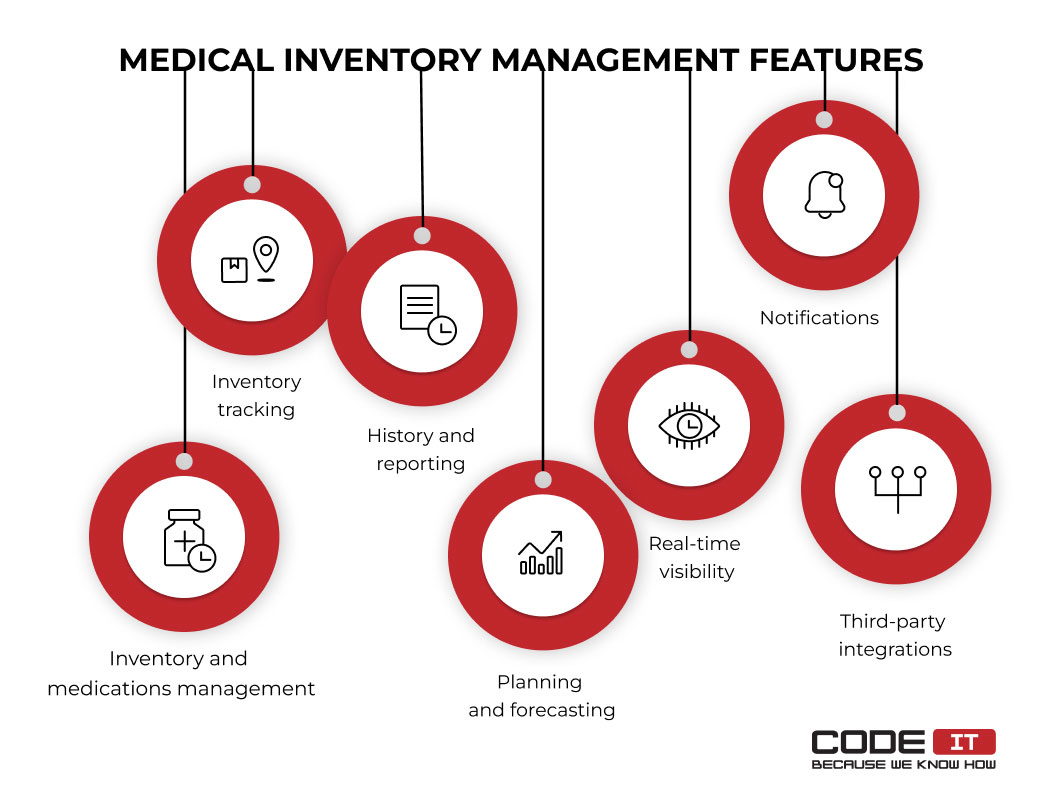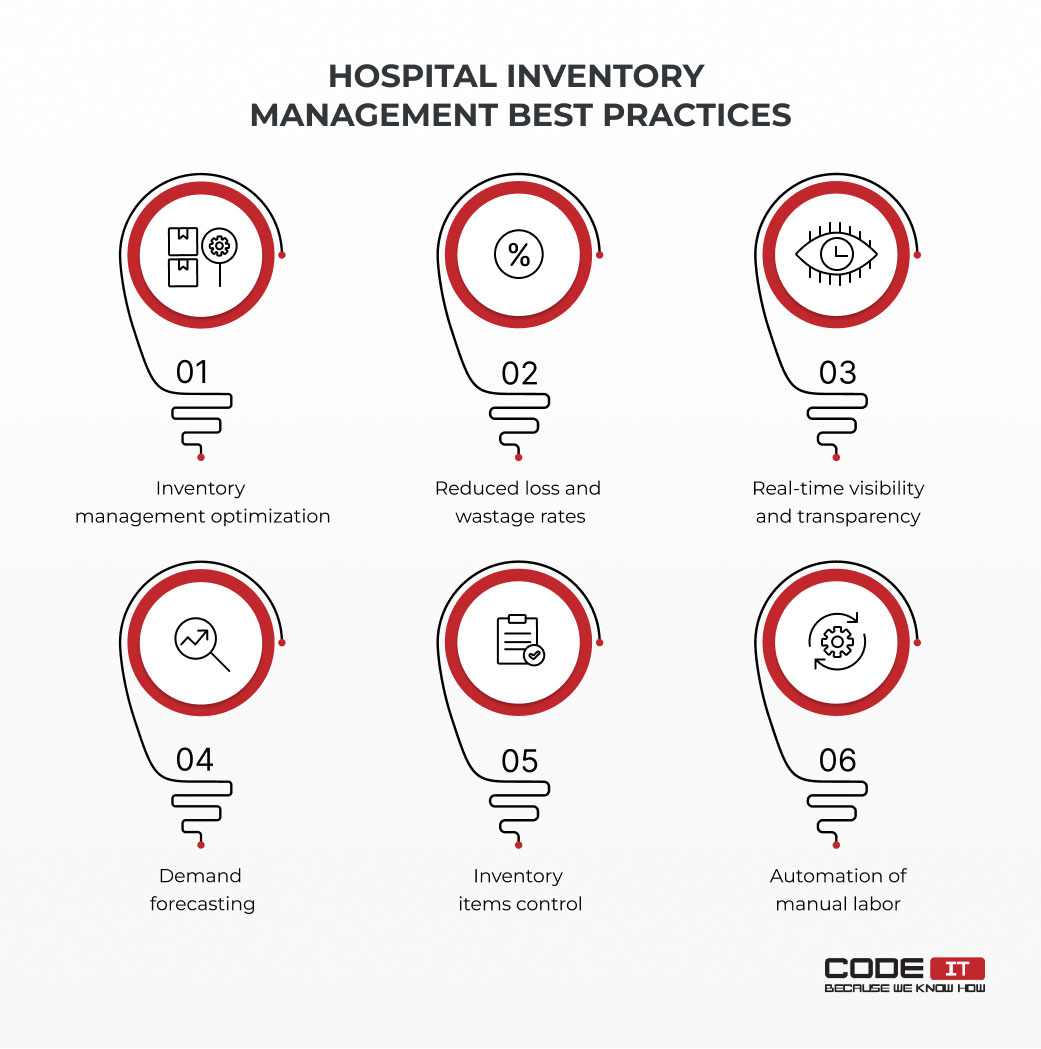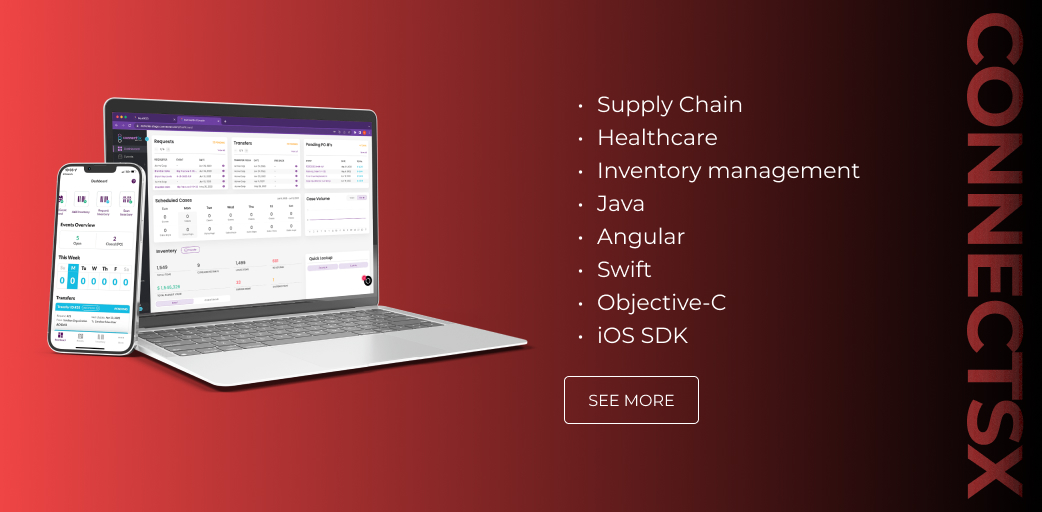Inventory Management in Healthcare — Architecture and Best Practices
New technologies and software solutions to store and track supplies help medical organizations improve performance, minimize errors, and cut operating costs.
Due to the benefits healthcare inventory management systems deliver to medical organizations, hospitals widely adopt them. The compound annual growth rate (CAGR) of the hospital inventory management market in 2023 has reached 7.9% and is expected to grow steadily.
The hospital asset tracking and inventory management systems market is expected to grow to $35.16 billion in 2027 at a CAGR of 6.6%.
WHAT IS HOSPITAL INVENTORY MANAGEMENT?
Inventory management in hospitals describes the process of tracking medications and materials at all stages, including purchasing, delivery, usage, storage, and utilization in medical facilities.
With the help of inventory management systems, medical staff can check the quality of in-stock items, their statuses, location, and other parameters using desktop, web, or mobile apps.
Adopting inventory management systems helps hospitals avoid shortages or overstocking of medical supplies. Also, it helps cut costs by increasing productivity, preventing theft, and decreasing the wastage rate.
A healthcare inventory management system helps medical staff to do the following.
- Track in-stock goods
- Manage goods and medications online
- Forecast demand for medications
- Receive detailed reports
- Track items travel in real time
- Receive notifications on supplies to re-order
The benefits of adopting inventory management in healthcare organizations are:
- control over in-stock inventory;
- demand planning & reporting;
- automation and processes optimization;
- reduced wastage and loss rates;
- compliance with regulatory requirements.
Get tailor-made system for your hospital
ARCHITECTURE OF HEALTHCARE INVENTORY MANAGEMENT SYSTEM
Inventory management in hospitals can be adopted by establishing various technologies to facilitate and automate inventory and medical supplies tracking.

Systems that help manage inventory for hospitals imply five major components.
- Database — The core of an inventory management system that foresees the opportunity to store and share data about in-stock inventory and medications.
- User interface — Desktop-, web-, or mobile-based applications that medical staff uses to submit orders and track the progress of their fulfillment.
- Backend functionality — Software that runs an inventory management system. Also, it offers the ability to process data, generate reports, send notifications, etc.
- Barcode or RFID scanning — Hardware tools and software to generate, print, and scan barcodes or RFID tags to identify goods in a warehouse.
- Third-party integrations — External software connected to medical inventory management in a hospital via API or HTTPS requests to fetch and send data to different systems seamlessly.
A system for healthcare inventory management can be installed on cloud-based or on-premises servers.
Medical Inventory Management Features
The core functionality of a system for inventory management in hospitals is to provide information about in-stock goods and medications and the opportunity to submit requests.

The seven core features of a clinic inventory management system are as follows.
1. Inventory tracking
It is the foremost feature that grants medical staff access to a database with information about in-stock, requested, and out-of-stock goods and medications. The database may imply records about items in a warehouse, including:
- name;
- count;
- expiration date;
- SKU code;
- price;
- adverse effects.
2. Inventory and medications management
With the help of a user-friendly application, medical staff can update data in an inventory management system or submit requests. For instance, they can request the delivery of certain materials or medicine. The request can contain information about goods that should be delivered, the time and location of delivery, and a recipient’s name.
3. Planning and forecasting
The implication of data analysis algorithms or the use of third-party services connected to an hospital management system enables medical staff to forecast the demand for medical materials and drugs.
Data-driven planning helps improve goods and medication management. Also, medical organizations can opt for the required number of materials or drugs to satisfy high demands that may occur regularly.
Read also:
4. History and reporting
A system used for inventory management in hospitals can analyze data and provide detailed reports on the use of goods, materials, and medications. Also, users can access a database using an application to discover the travel history of a selected inventory item.
5. Real-time visibility
Real-time updates on inventory items help medical staff monitor the fulfillment progress of their requests and discover the location of items that should be delivered.
6. Notifications
User applications that enable access to a healthcare inventory management system can deliver notifications to keep medical staff alerted about the following events.
- Fulfilled requests
- Status updates on inventory items
- Low inventory
- Expired items
- Unusual trends
The primary aim of this feature is to alert medical staff about critical events or problems that should be tackled immediately.
7. Integrations
The functionality of a system for inventory management in healthcare can be enhanced by adding third-party services using APIs.
The top integrations that can be connected to a medical inventory management system are as follows.
- Electronic health records (EHRs). It is a dedicated database that stores digitized information about patients, diagnoses, prescriptions, lab reports, etc. EHRs help improve the quality of services offered by medical institutions.
- Electronic data interchange (EDI). It is a service that enables healthcare organizations to exchange data by following specific rules and regulations. Data is converted to specific formats and transformed automatically before being transmitted from one organization to another and vice versa.
- Demand planning and forecasting system. It is a third-party system that foresees the opportunity to analyze collected data using pre-built algorithms or pre-trained machine learning (ML) models. For instance, the implementation of modern technologies foresees the opportunity to accurately predict demand for goods and medications and spot unusual patterns.
Feature-rich IMS for your hospital with CodeIT
The number of features that inventory management systems can imply isn’t limited. You can request software engineers to create any functionality when developing a new solution for a hospital from scratch.
HOSPITAL INVENTORY MANAGEMENT BEST PRACTICES
Systems for inventory management in healthcare are applied to solve a lot of various problems. They help improve performance, enhance inventory visibility, and cut operational costs.

Let’s discover how hospital inventory management systems work in the real world by exploring the best practices in more detail below.
1. Optimize Inventory Management
The implementation of a digital solution for inventory management in a hospital helps clearly understand what inventory is in-stock, discover its properties and location, and submit requests remotely using a desktop, mobile, or web application.
A centralized database of inventory items helps avoid stockouts and overstocks by re-ordering the minimum number of goods and medications required to run all operations in a medical facility seamlessly.
Also, using inventory management in hospitals helps optimize communication between departments. The medical staff must submit a request and track its fulfillment progress to receive certain items.
2. Reduce the Wastage of Medications
The improper storage, usage, and arrangement of medications in a warehouse can increase the wastage rate.
With a system that helps manage inventory for hospitals, medical staff can monitor the expiry date of pharmaceuticals. Also, they can apply the first-in-last-out approach to reduce the number of expired medicines.
A medical inventory management system can imply information about the required storage conditions for every item.
3. Add Real-Time Visibility and Transparency
Medical workers can update and access information about every inventory item in real time. They can track the progress of request fulfillment. Also, they can check inventory items’ location and travel history in live time.
Real-time visibility and transparency enhance planning and eliminate the need for workers to contact other departments for updates on their requests.
4. Forecast Demand and Stop Patterns
An inventory management system can collect much data on the flow of goods and medications in a medical institution. Using mathematical methods for time series forecasting or machine learning models, hospitals can accurately predict the demand for new items to replenish the optimal number of goods and medicines.
Besides, machine learning can detect patterns and unusual activity to prevent human error, improper usage of resources, or fraud.
Read also:
5. Control Items Access and Travel
Managers in a hospital organization can thoroughly monitor and control all the processes through a centralized system for inventory management in a hospital.
They can check pending and fulfilled requests, get detailed reports, and review in-house stocks. Also, they can assign roles and permissions to users to limit access to inventory items or data for certain users.
6. Automate Manual Activities
Automated inventory management in healthcare helps improve performance by eliminating the number of tasks that should be tackled manually.
For instance, an automated system can track in-stock inventory and send notifications to responsible users when it reaches the minimal level. Feature-rich systems can automatically place inventory replenishment orders.
Lack tech or domain expertise?
CHALLENGES SOLVED WITH HEALTHCARE INVENTORY MANAGEMENT
Hospitals and medical organizations face many challenges related to ordering, storing, and distributing goods and medications.

Established inventory management in hospitals helps avoid most issues, including the following.
- Complex ordering process. Usually, medical staff should communicate with many other departments to submit goods or medication orders.
- Time- and environment-sensitive materials management. Many medications have certain storage and transportation conditions that are obligatory to meet.
- Lack of real-time visibility. The medical staff needs to get real-time updates on requested items to improve planning and customer experience.
- Insufficient planning. Poor forecasting based on the assumptions of medical staff can lead to overstocking or lack of medications in stock.
- Extensive order fulfillment time. Ineffective management and many manual operations lead to extensive order fulfillment.
- A large number of manual operations. A lot of the labor force is required to fill in documents, update data on products, process requests, communicate with other departments, etc.
- High wastage rates. Due to insufficient planning, many medications may expire. Also, irrelevant storage and transportation conditions can change chemical composition.
- Poor patient satisfaction. Extensive order fulfillment and poor medical staff performance can decrease customer satisfaction.
- Missed or stolen inventory. Lack of visibility on inventory items increases the loss rate because of misplacement, removal, expiring, etc.
- Human factor mistakes. Errors in spreadsheets and other inventory management mistakes conducted by the labor force due to the human factor.
CODEIT’S EXPERTISE
ConnectSx is an innovative solution that helps optimize inventory management in a healthcare organization. Also, it provides complete visibility of all processes for clinic managers.
Problem
The client strived to optimize internal processes, reduce errors, and enable full visibility of the entire supply chain. The existing solution that was under development couldn’t help solve problems. Hence, the CodeIT team was involved in the project.
Solution
Our experts have conducted a technical audit by thoroughly analyzing the project and preparing a detailed reboot plan. We’ve rebooted the project and developed three standalone applications.
- Inventory management web app
- Inventory management mobile app
- UDI scanning mobile app
The developed applications enable the opportunity for hospitals to:
- Manage inventory and submit transfer requests
- Track inventory movement history
- Track product expiration dates
- Collect and analyze inventory data
- Automatically submit sales forms
- Find lost items
- Scan barcodes
Case study:
FINAL WORDS
A healthcare inventory management system is software that enables medical staff to manage and monitor all the goods and medications in a healthcare organization.
Users can access databases using web-, mobile-, or desktop-based applications to submit requests, check data, receive notifications, update information, etc.
The architecture of an inventory management system usually includes the following parts:
- database;
- user interface;
- backend functionality;
- barcode or RFID scanner;
- third-party integrations.
Systems for inventory management in hospitals help optimize performance, cut operating costs, spend resources wisely, and minimize loss and wastage rates. Also, they help automate manual operations and add transparency.
Business first — Code later
According to various studies, roughly half of the medical institutions track their inventory manually. For instance, they may use spreadsheets. Medical staff should manually update all the information about inventory items in the spreadsheets.
The other half of medical institutions use software for inventory management for hospitals. It implies the following components:
- user-end application;
- backend application;
- database;
- scanning hardware and software;
- third-party integrations.
The use of digital solutions helps optimize and automate a lot of processes.
It is the process of tracking inventory items in a hospital, including:
- pharmaceuticals;
- equipment;
- prescriptions;
- medical supplies;
- surgical instruments;
- janitorial supplies.
Digital solutions enable hospitals to track in-stock inventory items and their travel history using web, desktop, or mobile applications.
The top hospital inventory management best practices and benefits are the following.
- Inventory management optimization
- Reduced loss and wastage of inventory items
- Real-time visibility and transparency
- Demand forecasting
- Inventory items access control
- Manual activity automation
According to the Role of Technologies in Inventory Management guide, the three types of inventory management techniques in healthcare organizations are:
- Push. Items are delivered in advance and stored in a warehouse to meet the demand.
- Pull. Items are delivered to warehouses from suppliers only when requests from customers are submitted.
- Just-in-time. A minimum number of items are stored in a warehouse. Additional requests are processed using the pull strategy.
